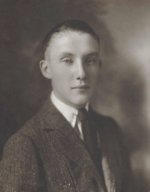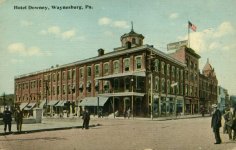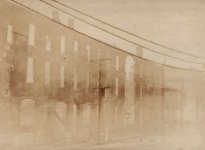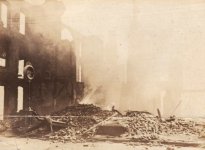
To serve in and from the flames:
The untold stories of the Downey House fire
By Eric Rush, for the Greene County Messenger
Dec 24, 2015

This photo from Cornerstone Genealogical Society of the Downey House in downtown Waynesburg was taken in the early 1920s and later made into a postcard. The photo was taken shortly before the devastating fire that claimed lives and destroyed several buildings. This week marks the 90th anniversary of the fire.
It has been 90 years since the cold mid-December night air brought disaster to the borough of Waynesburg, and especially to the Downey House.
While the tales of the deaths of those present and the ruin of three of the borough’s most noted buildings has been long remembered, it has been with the passage of time that some of those happenings — while not forgotten — have passed from living memory.
The names of those caught beneath the falling bricks of the Grossman Building — J. Thurman, William French, Victor Silvios, Harvey Call Jr. and Joseph Riffenberg — have all stayed fresh in the collective memory; however, the others who fought the flames and lived through that night have slowly faded from our collective memory.
It was a cold night and H.C. Schieber was alone operating in his jewelry shop on the first floor of the Downey House in Waynesburg. He was alone at 3:30 a.m. in the shop; it was a busy time, as he was repairing family heirlooms and creating totally new jewelry items. Further down on South Washington Street, just below the Downey House, at the Tasker Flower Shop lived Tony Vilella, the owner and florist. He was gaining a reputation in town for his floral arrangements which many in town considered clever designs.
Upstairs, on the second floor in the Downey House Hotel, the patrons of the hotel were fast asleep, tired from their various travels and business of the day. However, not all were asleep; H.G. Milton, an insurance salesman with Metropolitan Life, was having a rough time finding sleep as he was tossing and turning in his bed. Meanwhile, the man in charge of their accommodations, Mr. John Lofink, was in a deep sleep of his own. It was the early morning hours of Dec. 23, 1925 and on this night fate was to visit the small community of Waynesburg in a very large way that no one could imagine.
It was a hot dog stand, which many considered a “greasy spoon,” where the fire was to begin with a muffled gas explosion. At Shriver’s Jewelry Store down the street from the Downey House, Mr. Shriver and his assistant were closing up when they heard the muffled sound of glass shattering in the brisk cold night air. They quickly made their way down Fruit Alley and then West Cherry Alley and were confronted with the hot dog stand on fire. Splitting up, one went inside the hotel to alert the patrons and another went to sound the alarm.
In the Downey House itself, H.G. Milton was awakened by the noise coming from downstairs which he described as “a loud explosion [that was] followed by fire and smoke.” Even with the noise, John Lofink was still asleep and it was others pounding on his door that roused him to the commutation in the building.
Down the street, Tony Vilella was roused as well and had made his way up the street and into the Downey House itself where he aided the others in waking, and he also had the forethought to grab the registry from the desk.
Once outside, Tony Vilella and John Lofink (it is assumed) quickly made a head count of the patrons who had escaped from the quickly burning building, and because of that effort it was realized all had made it out safely. It was now that real efforts to combat the blaze started and the calls for other help from the surrounding communities were made.
Various records document the names of Edward VanCleve and William Cree and their near crushing under the falling debris of the copula and the statue of General Greene on the lawn of the courthouse as they worked a weak stream of water on the Downey House.
The one factor that would hinder all firefighting efforts that night was the poor water pressure from the borough’s outdated water system. Though normally it was good for everyday use, now with multiple hydrant connections being made on the same waterline, the streams only grew weaker and weaker. This was the situation that brought the fatalities into the line that would meet their fate.
But not all who were there would die; men such as Luther Renner would survive, though he would suffer from his injuries for the rest of his life. Even so, Renner would live a life dedicated to his community. He would earn a Masters degree in science from West Virginia University and work for 26 years with the state Department of Environmental Resources, and he served in the U.S. Army Air Forces in World War II.
Another of his fellow volunteers that night was Clovis Wright; he was not done fighting the “Red Devil,” as he would become a full active member of the Waynesburg Volunteer Fire Company in 1930. He would go on to serve in various positions of the fire company all the way to chief in 1946. In addition, he would long serve as borough councilman and as a part of various other civic bodies, such as the Lions Club.
There was no doubt that the community of Waynesburg was well served that night by its citizenry and those who ventured into town to join the struggle. But there is also no doubt that that same zeal is alive and well today in both its public and government interest.
Though all those who were there 90 years ago have left us, that commitment is still alive and well.
It has been 90 years since the cold mid-December night air brought disaster to the borough of Waynesburg, and especially to the Downey House.

www.heraldstandard.com







